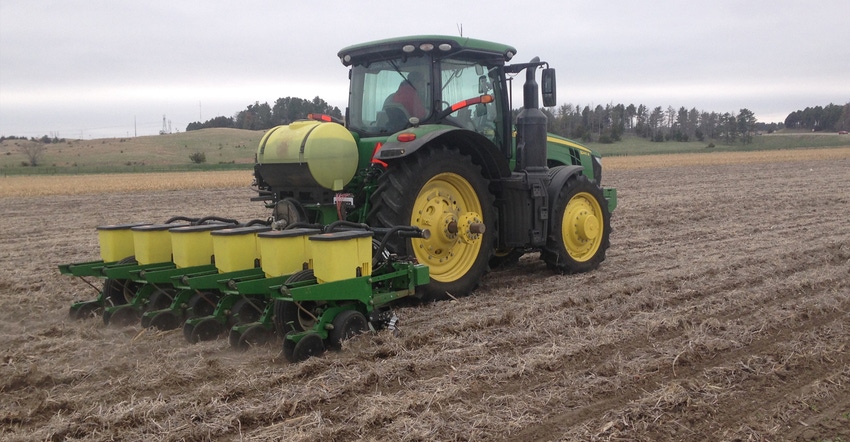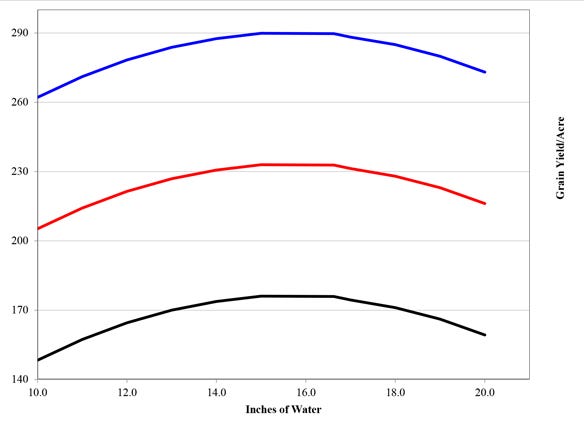June 3, 2019

By Matt Stockton
Marginal thinking can best be illustrated by an example: Take for instance the season-long question about applying irrigation water.
Marginal analysis or thinking follows a pattern of thought that seeks to find the economically optimal (most profitable) amount of water to apply. This thinking focuses on maximizing profit — not yield or revenue or even minimizing costs.
Consider the representative water-corn yield relationship illustrated in the table below. In our example, corn requires at least 10 inches of water to produce a minimal crop. Observe from the figure that each additional inch of irrigation up to a point increases yields. Yields, of course, depend on other factors, such as nitrogen, as shown in the figure by the three parallel curves with N levels of 0, 100 and 200 pounds per acre.

Corn yield at 0, 100 and 200 pounds of N fertilizer.

The yields in the table may not be completely realistic, but the key is that yields change with changes in water. Note that as more water is added, yields increase for all three N fertilizer levels. However, each increase is smaller than the increase in yield from the previous inch applied.
After a certain point, each additional inch of water is associated with a yield decrease. This is called a diminishing effect. From the figure, yield is maximized at about 15 inches of water and then begins to decline. Logically, no one would apply more than 15 inches of water, since yields would decrease, and those lower yields already are available by applying lower amounts of water.
Therefore, the economically optimal amount of applied water lies somewhere between 10 and 15 inches. But where? This can be estimated using the diminishing relationship, the value of the crop produced and the costs of the water. This is known as a marginal analysis.
Marginal analysis depends on the value and costs of the next added unit. If costs per acre-inch of water are the same for each inch, marginal costs are constant. A $9 per acre-inch cost for the first inch would be the same for every following acre-inch.
The marginal value of each inch of water depends on product value, i.e. corn price, productivity, which according to the table is diminishing. Marginal value is becoming less valuable for every added inch because of a productivity decline.
Calculating marginal value is simple: It's the number of added bushels per acre of corn produced by the additional acre-inch of water times corn grain price per bushel. The marginal value of an added acre-inch of water from 13 to 14 inches that increased yield by 3.68 bushels per acre with a $3 per bushel market value would be $11.04. With a $9 per acre inch marginal cost, it would be well worth applying that acre-inch of water.
By adding the next inch of water, going from 14 acre-inches to 15 acre-inches, the yield increase is expected to be lower — 2.35 bushels per acre, making the marginal value of that acre inch $7.05, which is much less than its marginal cost of $9. So, this last acre-inch of water would not be a profitable choice. The application of 14 acre-inches would be the most profitable application, if applications were limited to full acre-inches.
Does the return equal or exceed the costs? The information used to make these choices may not be clearly defined or readily available. What's important, however, is the concept and principle. Setting yield goals should be based on an understanding of crop responses, costs and crop values — not optimal yields, but optimally profitable yields.
Lower crop prices and higher input costs should result in more conservative yield goals compared with high crop values and lower input costs.
Comparing hybrid choices
Another analysis relates to productivity differences and comparisons among individual choices, such as corn hybrid selection. Many farm products are advertised as increasing yields, saving time, increasing capacity and so on. Many of these products, given the right circumstances, can enhance profitability.
However, the relationship between productivity and costs should never be confused. Any increase in productivity directly relates to increases in revenue. But in many cases, there are increases in costs as well. The question is: Are the changes in costs justified by the changes in revenue? This rule also applies to costs reductions and their associated revenue changes.
A simple, real-life example from the University of Nebraska's 2018 Testing Ag Performance Solutions farm management contest illustrates these points. It's helpful to remember that each of the farms in the TAPS contest have the same soil and weather conditions.
Farm 1 planted corn variety A with a cost of $74.43 per acre. If Farm 1 planted corn variety B, it would have cost $96.96 per acre. Which variety was the most profitable? It's impossible to tell without more information.
If all yields had been the same regardless of variety, and all other costs were identical, the choice would be obvious: variety A, which cost $22.53 per acre less than variety B. However, variety B outyielded variety A by 32.85 bushels per acre, with the same N and irrigation treatments. At a market price of $3.20 per bushel, that would amount to a $105.12 per acre difference in revenue.
The loss in revenue was far more than the cost savings from planting variety A, making the total estimated loss of income $83.07 per acre. The drop in yield from variety A would have to have been no more than 7.04 bushels per acre to justify the lower planting cost.
Now consider a case where costs are increased in hopes of increasing profit. Farm 2 planted variety C at a cost of $120.05 per acre, with a resulting yield of 288.5 bushels per acre. If Farm 2 had planted variety B instead, the planting cost would have been reduced to $96.96 per acre with yields estimated at 282.13 bushels per acre —about 6.37 bushels less.
Planting costs for variety C were $23.09 per acre more than variety B. Using a $3.20 corn value, the added yield would have an estimated worth of $20.38 per acre. The added costs of planting variety C are slightly more than the added revenue, resulting in $2.71 per acre reduction. If variety C had produced 1 more bushel of grain, or corn were valued at $4 per bushel, variety C would have been more profitable than B.
There are many more instances where making comparisons can be economically beneficial. In today’s farming environment, it takes many good choices to succeed, and not many bad choices to fail. The most economically successful farms have a balanced approach in all facets of their farming operation, including financial management, production, marketing and business management.
Stockton is a Nebraska Extension agricultural economist at the West Central Research and Extension Center in North Platte, Neb.
You May Also Like




